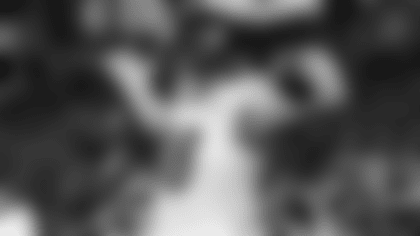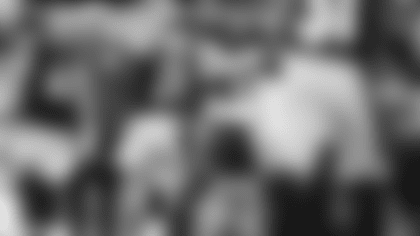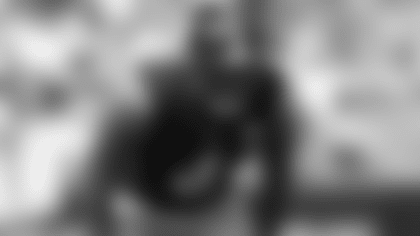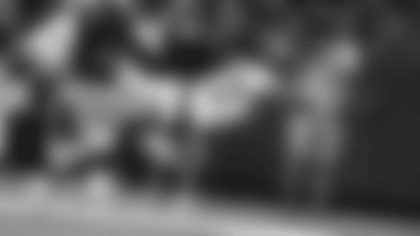Q. In assessing the performance last Sunday in Houston, you said, "There were several things that were very disappointing about the game. I think chief among them was the fact that Houston, we thought, was more physical than us and played harder than us." Is there anything to be done to remedy that as it's happening?
A. Certainly, and we did in-game. You felt it in the third quarter, but you're not afforded an opportunity to warm up to that component of play. Usually, there's a natural fight-or-flight response, and usually it's the positive one. But you're not afforded an opportunity to warm up to that component of play. It's a snowball effect, if you will, and they beat us to the punch early. We chose to defer, we kicked the ball off, and they ran 15 plays and went down the field and put points on the board. That's not the way you want to start games. You respond, we responded. But no, you don't want to warm up to that component of play.
Q. What are the advantages or disadvantages for the offense when the quarterback is under center vs. lined up in the shotgun, and is one of those formations more conducive to playing with a young quarterback?
A. Not necessarily is one more conducive to playing with a young quarterback). It's schematic-related. So much is done out of the shotgun today because of the zone-read component of play that's married so much with the drop-back rhythm passing game. That's why you see so many quarterbacks in shotgun these days. To be quite frank with you, almost all quarterbacks at the high school and collegiate level work in that shotgun or pistol-like capacity. Quarterback under center is just something from a schematic standpoint that's been lessened over the years, much like the nose guard or the fullback. There are trends in terms of the game and just where the game is right now that much of it is done out of shotgun.
Q. What are the pluses and minuses of the quarterback being under center vs. in the shotgun when it comes to running the football?
A. Cadence, the rhythm of the cadence. Quarterback under center has a chance to be much more crisp, the communication component of it. And then there are a variety of runs – and without getting into specifics in some of that stuff – there are a variety of runs that function exclusively with the quarterback under center. Everything doesn't go and go effectively out of the shotgun structure.
Q. When you're talking about cadence, do you mean that everybody on offense can hear the quarterback better?
A. Yes, and the rhythm of the cadence, as opposed to a foot lifting, or clapping, and things of that nature that usually accompany quarterbacks cadence in shotgun.
Q. With Kenny Pickett having injured his knee, and with the offense struggling, and the bye coming up after today's game, did you ever consider having him step away for a week and maybe get a different perspective by watching Mitch Trubisky?
A. Absolutely not. This is a competitive business. If he's healthy enough to play, you send him back out there and you allow that competitor an opportunity to compete. There is scarcity in our business. This is not NBA, where we get 82 regular season games or Major League Baseball. If you're healthy and you're capable, generally you're playing.
Q. So it didn't have anything to do with his mindset, his possible psychological reaction to maybe sitting a week?
A. None.
Q. You made the decision to have the team practice in pads on Wednesday. When you make that decision, does it have any impact on whether you give guys that day off to rest their bodies?
A. No, those decisions are not interrelated. One of the things that you acknowledge when you carry pads on a Wednesday is you're excluding certain people. It might be a veteran player who takes a little longer to get ramped up again the following week. Guys like (Patrick Peterson), who generally doesn't work on Wednesdays, and then maybe the guy who's injured and trying to get on a moving train and limited from a participation standpoint. When you wear helmets, you have an inclusive mentality. When you wear pads, you're excluding the potential of some of that participation. And so those are the variables in the decision making process. But based on where we are in terms of what we need to do, particularly at the early stages of the season, those padded practices are very necessary. We've had short weeks and travel issues that have made it necessary for us to practice in helmets only. It was critical for us to get back in those pads to lower our pad level to work on things relative to carrying our pads in an effort to get the desired result we want today, and particularly because it's the Ravens. If you remember, we played those guys late last year, and we carried pads on a Friday to make a point about the nature of this matchup, and particularly as it pertains to situational football – short yardage, goal-line things – that you typically practice on a Friday.
Q. You mentioned last year you practiced in pads on a Friday to make a point for the upcoming game vs. the Ravens. This week, you practiced in pads on Wednesday. How do you pick the day?
A. Usually it's Wednesday because that's when you put in your base installation, base running game, base play-action passing game and things of that nature. When I first came into the league years ago, there weren't any limits on padded practices. You always wore pads on Wednesday. You always wear pads on Friday because of short-yardage, goal-line. But it's a different league now from a rules perspective. It's fair because it's the same for all of us, and so I don't waste a lot of time comparing the present day NFL to what it was when I came into the league, because it's fruitless.
Q. How is a defense taught to defend screen passes?
A. It depends on the type of screens. Wide receiver screens, bubble screens, and things of that nature and things out in space, it's about perimeter gap control. The interior screens are things relative to the running back, and oftentimes success is dictated by the recognition of the rush and the redirection of the rush. And so really, when you talk about screens, there are two different philosophical things there in terms of fitting it or defending it. With the perimeter screens it's perimeter gap control; with running back screens is usually redirection of the rush-men.
Q. What should defensive players be looking for to indicate a screen pass is happening?
A. Nothing that they're not normally looking at, but they FEEL it. If you're normally rushing vs. an offensive lineman, and you win unusually easy, you FEEL that. If you're T.J. Watt and you always have two people blocking you, but it happens to be a tight end and he's by himself, that doesn't FEEL right. It is a feel thing if you're specifically talking about the redirection of the linemen. You don't necessarily look for anything different than what you normally do, but those plays feel a little different.
Q. What does an effective pass rush against Lamar Jackson look like, or maybe it's easier to describe what the pass rush should not look like if it's to be effective against him?
A. I think the second component is probably more appropriate. The key is to eliminate downhill escape lanes. That's where the chunks of yards are. That's where it really kills you. Obviously, we'd like to contain him in all facets, but everybody would. He's got special talents in terms of escaping the rush, and so there's certain parameters you put on it. And you definitively can't allow him to escape downhill. It needs to be lateral or in a retreat.
Q. Can a spy work against him?
A. I've seen people put spies on him, but spies are ineffective to be quite honest with you. What happens when people spy him generally is he beats the initial rush, and then there's a vertical space and now he's in a one-on-one with the spy. You're better off if you're spying him, just put the spy in the rush and minimize escape lanes. That's probably the most prudent approach. That's what I see people do. You used to see people spying significantly years ago, less so now. I think everybody just puts the spy in the rush.
Q. For a defense to be successful against Jackson, you said the players have to be good in space. How is that accomplished, and can it be practiced?
A. It certainly can be practiced, and this is how it's accomplished. What I mean is that there's a point of attack, and there's usually some perimeter component whether it's a naked (bootleg) or a jet (sweep), or a fake keep that tests your perimeter. It's no different than the option football that my generation grew up on. Option football makes you make one-on-one football plays and tackle in space. You better do a good job of reducing the amount of space that everyone plays in. You've got to set good edges and you have to tackle. It minimizes pursuit. There's never 10 and 11 people running to the football because there's a potential of something coming out of the backside, of Lamar keeping it and things of that nature. And so anytime you have less than 11 running to the ball that puts a premium on individual play, space play, tackling, things of that nature, and we have quarterback mobility in today's game. That's what it mirrors. It mirrors a triple-option that my generation grew up on that was really assignment specific, and then individual playmaking and tackling was at a premium. That's what the zone-read and some of the things that accompany the zone-read do in today's game.
Q. Are there kinds of situations – down-and-distance, red zone, goal line – where the Ravens like to go with designed running plays for Lamar Jackson?
A. It's evident by his four rushing touchdowns. He's always their leading short-yardage or situational rusher. He has been for a number of years. It's the difference between having escapability and having real quarterback mobility that needs to be dealt with schematically. Guys who are capable of escaping don't necessarily require schematic adjustments. When you start talking about designed quarterback runs, you've got to meet that fire with fire. You've got to play 11-on-11 football, and that's what you're forced to do when you're faced with the talents of a guy like him.
Q. Justin Tucker, the Ravens placekicker, has converted 90.2 percent of his field goal attempts over the course of his career, and he is 58-of-83, which is 69.9 percent, from 50 yards out or longer. How does he change an opponent's approach to defending the Ravens' offense?
A. The field position component of play is significant, and when you have good specialists, field position is affected in a big way. A case in point: we're in Baltimore a year ago in a big game. We've cut the lead to four, we're down, 13-9. We kicked the ball off and Justice Hill has a big kickoff return all the way across the 50, down to about our 40-yard line. Right about the time they tackle Justice Hill, I said, "We're down by 7," and it's just that mentality. (Tucker's) leg and what it does is significant. Now thankfully in that sequence, they went for it on fourth down and we stopped him, and then we went down and scored a touchdown and eventually I think we won the game by three points. But as soon as Justice Hill crossed that 50 yard line with a kickoff return, my mentality on that sideline is that a 4-point game just became a 7-point game. And that's the significance of a leg of a guy like Tucker.
Q. Today will be the 34th time you have been on the opposite sideline of a Ravens team coached by John Harbaugh. What would you say is the common characteristic of every John Harbaugh-coached team you have gone against?
A. You know, I don't know that I look at it in that way. I look at it in terms of the spirit of the significant players. It's not about me, it's not about John. And I'm sure he'd say the same thing. In the early years when he and I were involved in this thing, it was the personalities, it was Hines Ward and Ray Lewis, if you will. It's the players who play in this thing, Ben (Roethlisberger) and (Terrell) Suggs. You know these intimate relationships. The relationship that Najee is developing with Patrick Queen and that linebacker group. I think that's what defines this matchup. Wideouts and corners. Marlon Humphrey and George Pickens. It's just what I think about. I think about the significant players and now that he and I have been in enough of them, some of (them are "gold jacket" types. That's what makes this rivalry what it is.














